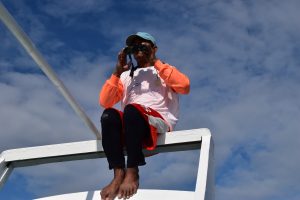Tañon Strait
In July, we went to the Philippines to visit the Biodiversity Management Bureau and RARE to discover the largest protected seascape of the Philippines. The Biodiversity Manamagent Bureau focuses on maintaining and enhancing the biodiversity in the Philippines. Several vulnerable marine areas has been marked as Marine Key Biodiversity Areas (KBA’s). These KBA’s have a high priority when it comes to the preservation of their biodiversity.
The Tañon Strait Protected Seascape, located between the Islands Cebu and Negros, is the largest marine protected area in the Philippines with an area of 5.182 km2. The Tañon Strait is a narrow street with a width of 27 km and 160 km long. This area attracts many different species such as 14 species of dolphins and whales, sharks and manta rays.
Vincent Hilomen and Rizza J. Sacra from the Biodiersity Management Bureau invited us in Dumaguete, a city located at the Tañon Strait, to talk about the importance of the protection of the Tañon Strait and to show us how they are protecting it.



Dolphins in the Tañon Strait
On the first day of our meeting we went to Baïs at 5 AM. We took the boat to spot dolphins in the Tañon Strait. The water was calm, the sun was shining and we were sailing out early what increased our chances to spot dolphins. After an hour of sailing, our dolphin spotter saw the first group of dolphins.
Once we reached this group of dolphins, we saw hundreds of dolphins swimming around our boat. Frequently, groups of dolphins approached our boat and swam in front of our boat. At a distance we saw spinner dolphins twirling in the air, they gave us a wonderful show for two hours. After seeing so many beautiful dolphins, we realised the importance of the Tañon Strait for these animals.
Transplantation of corals
After two hours we went to another important area where since a year, living coral is replaced from undamaged areas to this damaged and coral poor area. Three men are working eight hours a day to tie up the living coral to nets or steel racks lying on the bottom of the sea. After a year of doing this, a large part is covered with different types of coral and it looks beautiful.

Fishermen are not allowed to fish in these damaged areas and other vulnerable areas in the Tañon Strait. Rangers are monitoring these areas on a daily basis. Another part of the plan to increase biodiversity, is planting mangrove trees. Mangrove forests are a safe environment for small fish that in turn attracts and feed the bigger fish. The bigger fish are food for the larger organisms, such as dolphins and whales.

Sustainable fishing in the Tañon Strait
With an amazing view we ate our freshly prepared lunch on the boat near the mangrove forest. After lunch we interviewed various stakeholders including local fishermen who earn their living in the Tañon Strait.
The fish population and in turn the fish catch has declined significantly for the recent years due to human influences, natural disasters and illegal fishing. Formerly, fishermen used to fish with dynamite to increase their daily catch. On a longer term, dynamite fishing had the opposite effect. The value of their daily catch usually varies now between five and ten dollars a day. The Biodiversity Management Bureau and RARE are fighting against illegal fishing with programs supporting sustainable fishing. The fishermen told us they are happy with the measures against illegal fishing. Most of the fishermen understand that in the long term it is better to fish in a sustainable way.

Day 2: Fishforever with RARE
The next day, RARE took us to manjuyod, a village located near the Tañon Strait where many people owe their income to this area. RARE (an NGO) is trying to launch the program "Fish Forever" in the Tañon Strait. In our next blog we will tell you about our day with RARE. To be continued..
